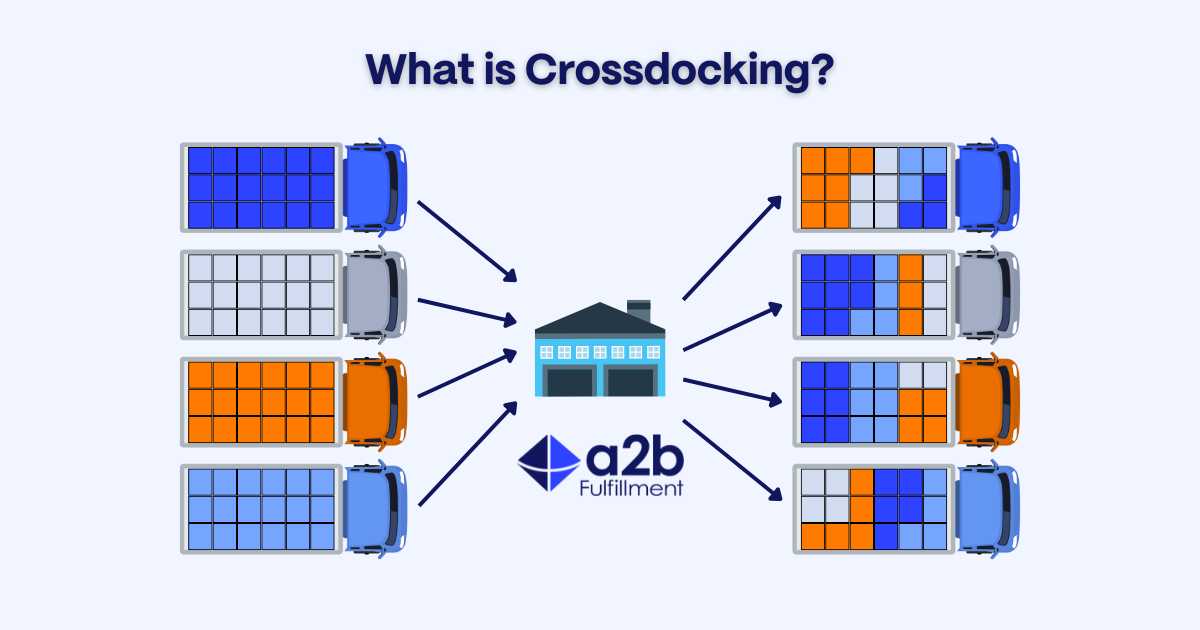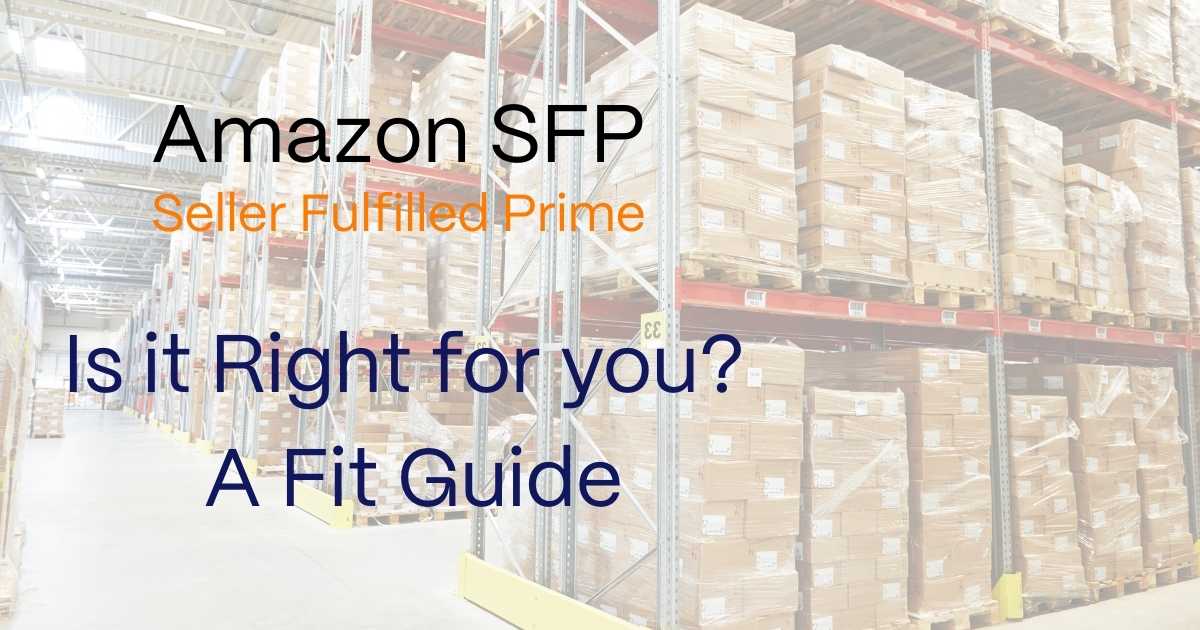Amazon FBA, or Fulfillment by Amazon, is the service provided by the e-commerce giant that allows sellers to store their products in Amazon fulfillment centers as well as take advantage of Amazon’s value-added services like picking, packing, shipping, and customer service. Evaluating the worth of Amazon FBA in 2024 is crucial due to the ever-changing landscape of eCommerce and the increasing competition in the online marketplace.
The Amazon FBA market has become increasingly saturated, however the demand for Amazon’s services has also increased. In fact, Amazon boasted a revenue of 576 billion U.S. dollars in 2023, a 62 billion dollar increase from 2022. This blog will be a comprehensive guide to understanding the benefits and drawbacks of Amazon FBA and provide all necessary information for companies to make the educated choice if Amazon FBA is the right fit for their company.
What is Amazon FBA?

How Amazon FBA Works
The Amazon FBA process consists of four major steps to provide quick, accurate shipping and customer satisfaction.
- Product Preparation and Shipment to Amazon: Sellers prepare their products to fit the Amazon packing and labeling standards. These requirements may seem tedious and inconvenient, but compliance with the Amazon guidelines allows for a more accurate and fast delivery of a company’s products.
- Storage at Amazon’s Fulfillment Centers: Once products are received by Amazon, they are integrated with Amazon’s warehouse management systems to allow the tracking of inventory levels.
- Order Fulfillment Process: Once a customer places an order on Amazon’s website the order fulfillment process begins. This process includes the picking, packing, and shipping of the product to the customer.
- Customer Service and Returns Handling: Finally, Amazon completely takes care of the returns of any product shipped through Amazon FBA. This process includes the inspection of returned products and either returning them to the seller’s inventory or disposing of them. Furthermore, Amazon provides customer service on behalf of all Amazon FBA sellers to handle customer inquiries and any other issues related to the products.
The Pros and Cons of Amazon FBA in 2024

Advantages of Amazon FBA
- Advanced Logistics Management: With their over 200 fulfillment centers throughout 10different countries Amazon provides an extremely strong network of fulfillment centers. Amazon’s vast fulfillment centers coupled with advanced warehouse management systems work together to provide quality storage and shipping for those all around the world.
- Prime Eligibility and Faster Shipping: Products fulfilled by Amazon are automatically eligible for Amazon Prime. With more than 200 million Prime subscribers globally, working through Amazon FBA allows sellers to best appeal their products to the market and retain customer satisfaction through the 2-day delivery provided by Prime.
- Customer Service Handling: Amazon’s customer service capabilities allow Amazon FBA sellers to outsource all their customer service needs entirely and leave any product inquiries, complaints, or feed back in the hands of Amazon’s customer service professionals.
- Increased Reach and Customer Trust: A huge advantage to Amazon FBA is the credibility that selling through Amazon gives your product. Customers know that products sold on Amazon are typically reliable and can be returned quickly and easily if needed. In fact, in 2023, Amazon ranked first as the most trusted retail and e-commerce brand in the United States.
- Scalability: Due to Amazon’s vast resources companies can easily scale their business through Amazon FBA. Whether the business is rapidly growing or is trying to account for fluctuating demand, Amazon has the resources to accommodate most seller’s needs.
Drawbacks of Amazon FBA
- Costs and Fees: Amazon charges fees for inventory storage, picking, packing, and shipping as well as a monthly Amazon FBA membership fee. These fees can result in the reduced profitability of a business because many of the fees are on a per unit sold basis.
- Dependence on Amazon’s Policies and Platform: Amazon frequently updates its policies regarding its fees and product requirements. This can be difficult and costly for businesses to adjust to and can even result in penalties if not adhered to.
- Inability to Build Brand Reputation: While shipping through Amazon FBA can be convenient it does have a negative effect on a company’s ability to build their brand’s awareness. Shipping directly or by means of a 3rd party logistics (3PL) company can give companies the ability to own the relationship with the customer and build brand awareness by customizing the packing list, using branded packaging and communicating with the customer. These opportunities build a company’s reputation instead of Amazon’s.
- Challenges with Inventory Flexibility: When using Amazon FBA a company’s inventory becomes much less flexible. Companies need to stock Amazon warehouses resulting in the inability to use that inventory for any other sales channels. On the contrary, when using direct fulfillment or through a 3PL, inventory is available for all sales channels and there is no need to spend on prepping the inventory to meet Amazon FBA requirements.
Cost Analysis of Amazon FBA

Product Fees
- Fulfillment Fees: These fees cover the cost of all picking, packing, and shipping products.
- Order Handling Fee: Cost per order processed.
- Pick and Pack Fee: Cost for picking and packing the items.
- Weight Handling Fee: Cost depending on the weight of the product.
- Storage Fees: These fees are charged monthly based off the amount of space a company’s inventory takes up. This fee regularly fluctuates seasonally, but typically ranges from $0.56 to $4.28 per cubic foot of inventory.
- Aged Inventory Surcharge: This fee is a surcharge on any inventory that has been in the Amazon FBA warehouse for between 181-365 days. The cost of this fee varies depending on how long the inventory has been in the Amazon warehouse, but ranges from $0.05 per cubic foot to $6.90 per cubic foot.
- Low-Level Inventory Fee: This fee is charged when a product's inventory level consistently remains low in proportion to its demand.
- Removal and Disposal Fees: These fees apply when sellers request Amazon to remove or dispose of their remaining inventory. These fees are dependent on the size and weight of the inventory but range from$1.04 per item to $2.89 per item for normal items and $3.12 per item to $14.32per item for oversized items.
- Return Processing Fees: This is the fee that Amazon charges for processing a return from a customer. The fee is either $5.00or 20% of the refunded charge, whichever is the least.
- Labeling Fees: $0.55 fee to have Amazon apply the barcode labels to inventory.
- Referral Fees: The referral fee is a variable cost that is a percentage of a product's price depending on the product's category. This fee can range from 8% of the product’s price to 45% of the product’s price.
Other miscellaneous fees apply, click here for more information.
Comparing FBA with Other Fulfillment Options

While somewhat unique Amazon FBA is not without competition in the order fulfillment market. There are suitable alternatives that have both advantages and disadvantages when compared to Amazon FBA.
- In-House Fulfillment: Refers to the handling of all aspects of the order fulfillment process within one’s own company. The benefit of In-House Fulfillment is the flexibility of operations that it allows companies to have. In-house fulfillment allows for total control over the company’s operations and the ability to customize fulfillment to meet the company’s needs. However, In-House Fulfillment is not without flaws. To control the entire order fulfillment process companies, have much higher upfront costs because they must invest in their own warehouse space, equipment, software, and staff. This not only is extremely time-consuming, but it also hinders a company’s potential to scale order fulfillment to meet an increase in demand. And most of all, these costs are largely fixed as companies will pay for their space all year long even when inventory is low.
- Third-Party Logistics (3PL): Refers to the outsourcing of warehousing, fulfillment, and transportation, to an external provider of these services. While similar to Amazon FBA, a 3PL does provide some unique benefits. Outsourcing to a 3PL allows for greater flexibility. Companies can take advantage of the customization of packing, shipping, and fulfillment processes. A 3PL can typically accommodate custom branding and complex handling requirements. A 3PL offers the ability to integrate with multiple sales channels, instead of only integrating with Amazon’s platform. The costs and fees of a 3PL are typically lower than that of Amazon FBA. Finally, a 3PLallows for a stronger relationship with customers due to increased control over the customer experience and communication.
- a2b Fulfillment provides all these 3PL services and allows companies the opportunity for fast, reliable, and cost-effective order fulfillment services, while keeping inventory flexible for other channels. For those that want to leverage Amazon FBA, a2b is also adept at shipping goods to FBA, including managing Amazon’s packing, labeling and routing requirements. a2b provides the barcoding, repacking, inventory storage and management, kitting and assembly, and order fulfillment to FBA. These services allow companies to focus their efforts on more important issues instead of worrying about meeting Amazons requirements.
Is Amazon FBA the Right Choice for your Fulfillment?
Assessing Your Business Needs
- Product Type: It is important to consider the product category, physical attributes, and demand when assessing if Amazon FBA is a good fit for your company. For product category it is important to assess if the product is easily packed, shipped, and stored. For example, if your product needs refrigeration it will be much more expensive to store and ship that product. The physical attributes like size and weight of the product must also be considered because the larger and heavier the product, the greater the Amazon FBA fees will be. Finally, the demand for the product is important to assess. If a product has a seasonal demand that fluctuates greatly, it may be difficult to optimize the amount of inventory in the Amazon FBA warehouses. This puts you at greater risk of the aged inventory surcharge and/or low-level inventory fee.
- Target Market: Assessing the target market of your product is essential to assessing if Amazon FBA is the best choice for your company. For example, if your target market is millennials who value 2-day shipping, Amazon FBA would be a smart choice because of its Prime eligibility. However, if your target market is in the 60+ age range then maybe they do not need such fast shipping and would be satisfied with slightly slower shipping.
Calculating Potential ROI

Amazon provides a calculator to estimate all of the Amazon FBA fees that would apply to your product. These fees calculated by Amazon’s profit calculator can then be used in a return on investment (ROI) formula:

Or further broken down

Solicit quotes from a reputable 3PL and run the above model again to see how it compares to Amazon FBA.
Making an Informed Decision - Alternative Fulfillment Strategies to Consider
It is important not to overlook in-house fulfillment and/or the services of a 3rd party logistics company (3PL) as they often are best suited for your company's needs.
Conclusion

3PLs can be an integral partner to keep your FBA costs down, while maintaining Amazon’s strict delivery times. Providers like a2b allow for greater flexibility, customized packaging, and omnichannel fulfillment.
Another significant advantage of outsourcing fulfillment is real-time reporting and analysis of your inventory and shipping. These data insights can help guide your company’s strategic initiatives.
Customer service and satisfaction are two elements that can either hinder or help your brand’s reputation. By outsourcing fulfillment, your company can build stronger relationships with their consumers.
However, it is crucial to assess whether outsourcing to a 3PL or Amazon FBA is the best fit for your company, considering its numerous fees and potential impact on brand development.
Contact us to learn how a2b fulfillment can simplify the Amazon FBA process and provide the benefits a 3PL for your company.






